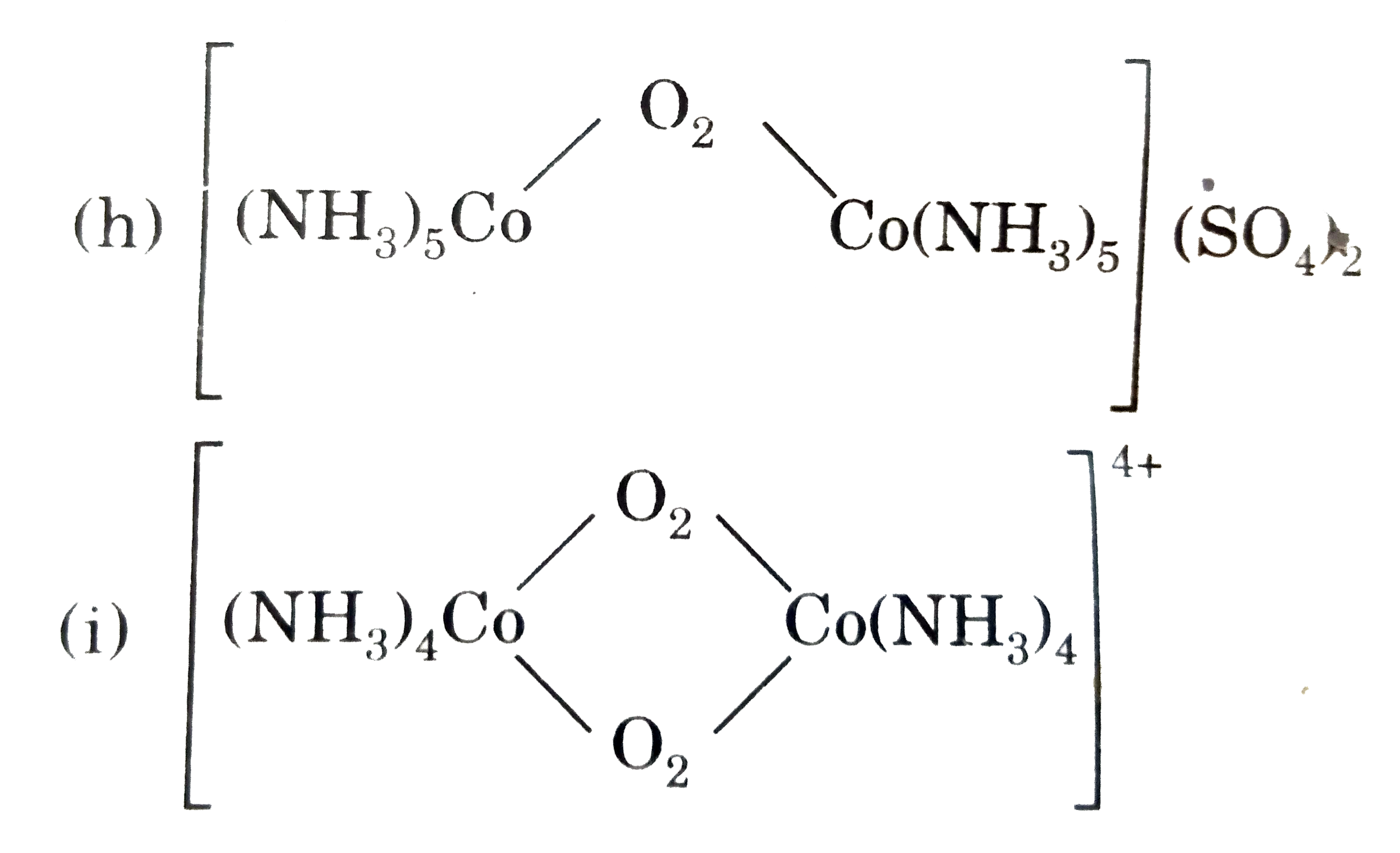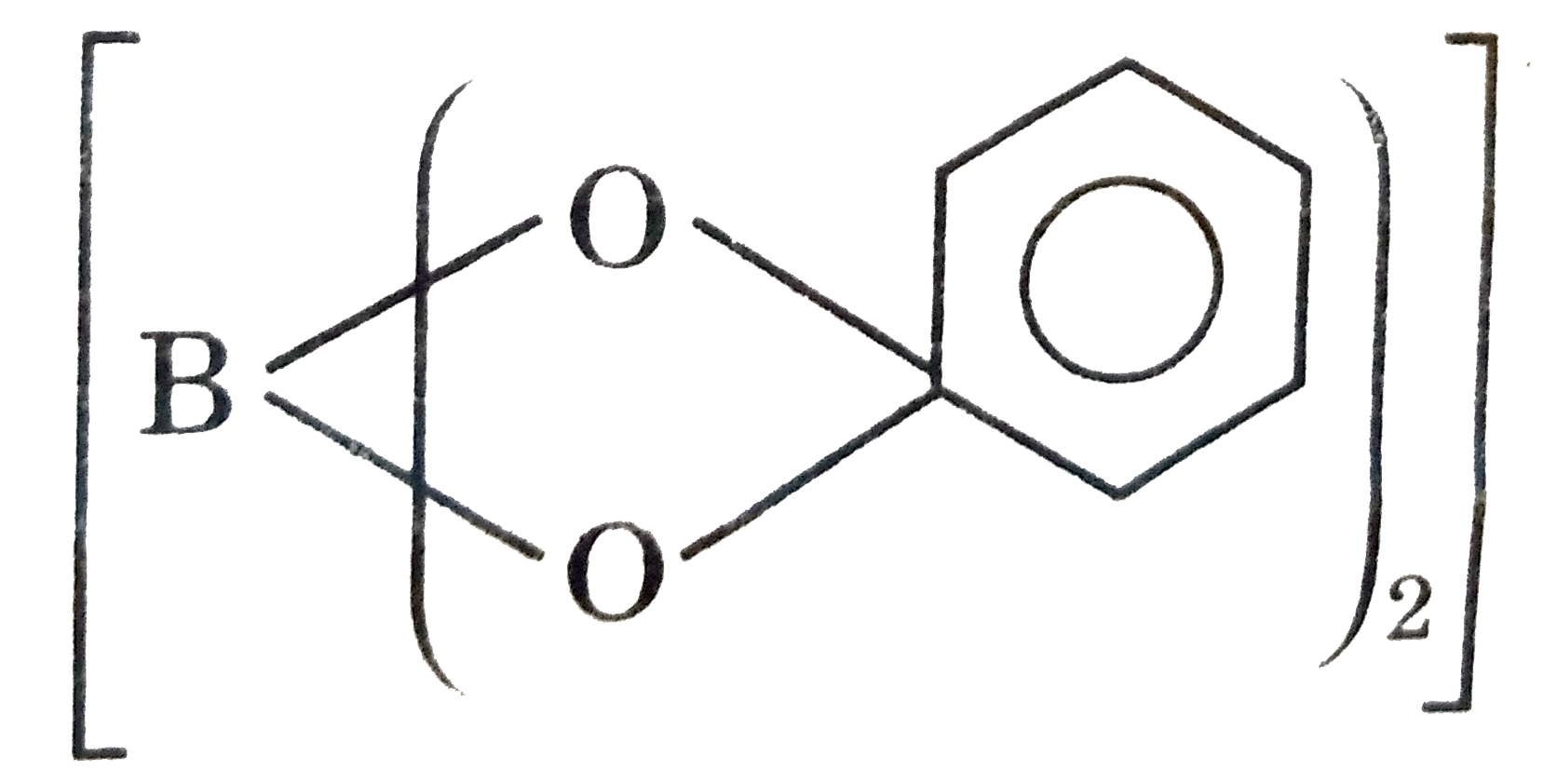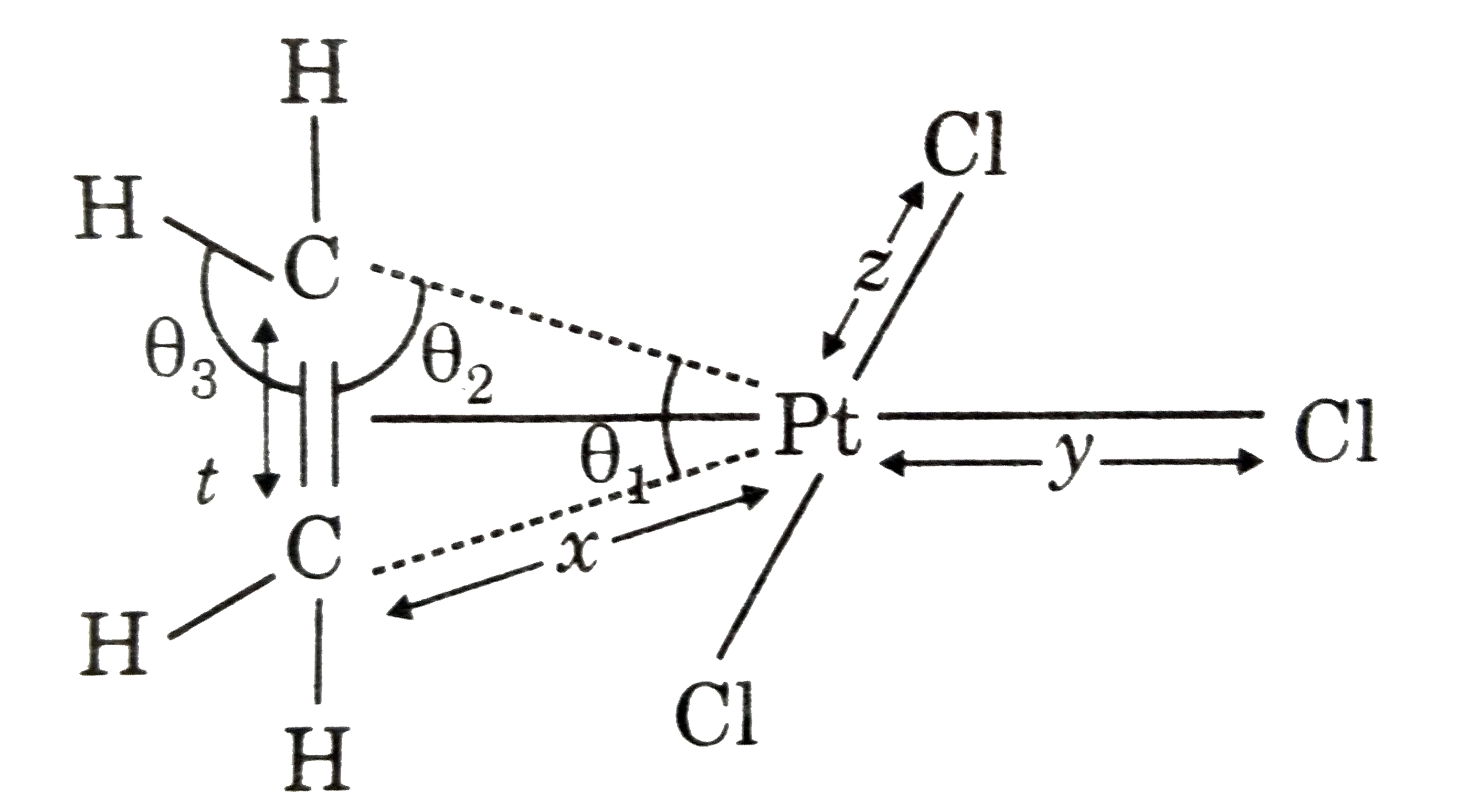Complete Solutions to SBJECTIVE TYPE of chapter COORDINATION COMPOUNDS of Class 12 book with complete answers and questions
| Class 12 | CHEMISTRY |
| Chapter | COORDINATION COMPOUNDS |
| OP TANDON | SBJECTIVE TYPE |
| Number Of Questions | 96 |
| Academic Year | 2023-24 |
Find the total number of optically active compounds in `[Zn(bm)(en)]Cl_(2)`.
View SolutionFind the total number of ligands which act as `pi-acceptor`.
`O^(2), F^(-), CO, CH_(3)NC, CN^(-), CH_(3)O^(-), OH^(-), CH_(2)=CH_(2), NO^(+), PF_(3), AsF_(3)`
[If your answer is 2, write your answer is 2, write it as 0002.]
View SolutionHow many of the following species would have C-O bond length longer than that of free CO molecule.
`[V(CO)_(6)]^(-), [Ti(CO)_(6)]^(2-), [CO(NH_(3))_(3)(CO)_(3)]^(3+), [Cr(CO)_(6)], HMn(CO)_(5), Mn_(2)(CO)_(10), [Fe(CN)_(5)(CO)]^(3-), CO_(2), CO_(3)^(2-)`
[Write your answer as 0003, if it is 3.]
View SolutionHow many of the modern formula are correctly matched with the structures preicted by werner's coordination theory ?


Write your answer as 0004 if your answer is 4.
View SolutionFind the sum of optically active isomers of both `[Pt(gly)_(2)Cl_(2)]" and "[Co(en)_(2)Cl_(2)]`.
View SolutionFind the total number of diamagnetic complexes.
`K_(3)[Fe(CN)_(6)],[Co(NH_(3))_(6)]Cl_(3), Na_(3)[Co(Ox)_(3)], [Ni(H_(2)O)_(6)]Cl_(2), K_(2)[Pt(CN)_(4)], [Zn(H_(2)O)_(6)](NO_(3))_(2), K_(2)[NiCl_(4)],[Pt(NH_(3))_(2)Cl_(2)], [Ni(CO)_(4)]`
View SolutionConsider the following complex entities.
`[FeF_(6)]^(3-), [Fe(H_(2)O)_(6)]^(2+), [Mn(CN)_(6)]^(4-), [Co(gly)_(3)], [Co(EDTA)]^(-), [Pt(NH_(3))_(2)Cl_(4)], [PtCl_(2)(en)_(2)]^(2+)`
If W, X, Y and Z are the total number of diamagnetic, paramagnetic, capable of exhibiting stereoisomerism and coloured complex entities respectively, find WXYZ. If W,X,Y and Z are 2, 4, 3, 6 respectively, write your answer as 2436.
View SolutionWhich of the following is tetrahedral and paramagnetic ?
`MnO_(4)^(-), CrO_(4)^(--), Cr_(2)O_(7)^(2-), MnO_(4)^(--), CIO_(4)^(--), CIO_(3)^(--), NO_(2), N_(2)O_(4)`
[If your answer is 5 so write 0005.]
View SolutionFind the number of paramagnetic species each central metal ion having `t_(2g)^(6)e_(g)^(0)` configuration.
(a) `K_(4)[Fe(CN)_(6)]`
(b)
(c ) `K_(4)[Fe(CN)_(5)O_(2)]`
(d) `K_(3)[Co(CN)_(5)O_(2)]`
`[Fe(CN)_(5)O_(2)]^(-5)`
(f) `Na_(2)[Fe(CN))_(5)NO^(+)]`
(g) `K_(4)[Co(CN)_(5)O_(2)]`
(h)
(i)
View SolutionWhich of the following compounds are coloured due to charge transfer ?
`(a) KMnO_(4)" "(b) K_(2)Cr_(2)O_(7)`
`(c ) K_(2)CrO_(4)" "(d) Na_(2)[Fe(CN)_(5)NO]`
`(e ) CrO_(2)Cl_(2)" "(f) K_(3)[VO_(4)]`
`(g) [Fe(H_(2)O)_(5)NO]SO_(4)`
View SolutionHow many compounds are tetrahedral in shape ?
`(a) KMnO_(4)" "(b) K_(2)Cr_(2)O_(7)`
`(c ) K_(2)CrO_(4)" "(d) K_(4)[Ni(CN)_(4)]`
`(e ) Be(acac)_(2)`
(f)
`(g) [Pd(NH_(3))(H_(2)O)(Br)(Cl)]`
`(h) [Pt(acac)_(2)]`
`(i) [Ni(CO)_(4)]`
View Solution`[(H_(2)O)_(8)Fe_(2)(OH)_(2)].(SO_(4))_(2)`
Calculate the coordination number of central metal, E.A.N., Primary valencies.
[If the coordination number is 4, EAN is 18, Primary valency = 2 than answer is 4182.]
View SolutionFind the number of compound which has four orbitals participating in hybridisation in central atom.
`(a) K_(2)CrO_(4)" "(b) K_(2)Cr_(2)O_(7)`
`(c ) KMnO_(4)" "(d) K_(2)MnO_(4)`
`(e ) [Ni(CN)_(4)]^(2-)" "(f) [NiCl_(4)]^(2-)`
`(g) [PtCl_(4)]^(2-)" "(h) Na_(4)P_(2)O_(7)`
`(i) H_(2)S_(2)O_(8)`
View SolutionHow many of the following has 2.8 B.M. magnetic moment ?
`(a) [Ni(NH_(3))_(6)]Cl_(2)" "(b) K_(4)[NiCl_(6)]`
`(c ) K_(3)[Mn(CN)_(6)]" "(d) [NI(CO)_(4)]`
`(e ) [Ni(CN)_(4)]^(2-)" "(f) Hg[Co(SCN)_(4)]`
`(g) K_(3)[Fr(CN)_(6)]`
View SolutionCalculate the coordination number and number of stereo isomers of
`[Co(gly)NH_(3)(CO)(H_(2)O)Cl]Cl_(2)`
If your answer is 4 and 20 then write 0420.
View SolutionFind the value of `m+n` in the anionic species `[Ti(CO)mp^(n-)`, if it follows E.A.N. rule and complex is octahedral ?
View SolutionFind the number of species having C-O bond length grater than that in free CO molecule.
`Fe(CO)_(5), (CO_(3)^(2-), CO_(2), Ni(CO)_(4), [Cr(dien)(CO)_(3)], [Co(CO)_(4)]^(-), C_(3)O_(2), H[Mn(CO)_(5)]`
View SolutionConsider the complex `[Co(NH_(3))_(5)(CO_(3))]ClO_(4)`, the coordination number, oxidation number, number of unpaired d-electrons respectively are :
If your answer is 4, 2, 1 write your answer as 0421.
View SolutionSelect the total number of properties which are correct with respect to
`K_(4)[Fe(CN)_(5)O_(2)]` or any of its isomers (`d^(6)` configuration of central metal ion).
(a) Paramagnetic
(b) Inner orbital complex
(c ) Low spin complex
(d)`Delta_(0) gt P`
(e ) Shows optical isomerism
(f) Shows linkage isomerism
View SolutionHow many of the following obey's Sidgwick EAN rule ?
`(a) K_(4)[Fe(CN)_(6)]," "(b) K_(3)[Fe(CN)_(6)]`,
`(c ) Mn_(2)(CO)_(10)," "(d) [Fe(H_(2)O)_(5)NO]SO_(4)`,
`(e ) Na_(2)[Fe(CN)_(5)NO]," "(f) [Co_(2)(CO)_(8)]`,
`(g) [Fe(pi-C_(5)H_(5))_(2)]`
View SolutionHow many of the following compounds splitting energy `(Delta)` is greater than pairing energy (P) ?
`(a) Fe(Co)_(5)," "(b) [Co(H_(2)O)_(6)]^(3+)`
`(c ) [Mn(NH_(3))_(6)]^(2+)," "(d) [Ir(H_(2)O)_(6)]^(3+)`
`(e ) Na_(2)[Fe(CN)_(5)NO]," "(f) [Ni(CO)_(4)]`,
`(g) [PtCl_(4)]^(2-)" "(h) [Co(H_(2)O)_(3)F_(3)]`
View SolutionFor what minimum value of n, polymerisation isomers of `[Fe(NH_(3))_(3)(NO_(2))_(3)]_(n)` would not exist ?
View SolutionIf the complex `[Mo(CO)_(4) Br(CPh_(3))]` follow 18 electron rule or EAN rule, find the bond order of Mo-C bond .
View SolutionFind the total number of compounds/ions having linear shape.
`[Ag(CN)_(2)]^(-), HgCl_(2), SnCl_(2), NO_(2)^(+1), ClO_(2)^(+), AuCl_(2)^(-), Hg_(2)Cl_(2)`
View SolutionFind the total number of diastereomers of the complex `M_(a_(2)b_(2)c_(2))` where M is the central metal atom/ion and a, b, c are monodentate achiral ligands.
View SolutionFind the number of complexes involving `d^(2)sp^(3)` hybridisation of the cental metla atom/ion.
`(a) [Co(Ox)_(3)]^(3-)," "(b) [Mn(CN)_(6)]^(4-),`
`(c ) [Mn(NH_(3))_(6)]^(2+)," "(d) [CoF_(6)]^(3-),`
`(e ) [Co(gly)_(3)]," "(f) [Pt(NH_(3))_(6)]^(4+),`
`(g) [Ni(H_(2)O)_(6)]^(2+)," "(h) [Co(H_(2)O)_(6)]^(3+),`
`(i) [IrCl_(6)]^(3-)`
View SolutionFind the total number of compounds or ions having O-O bond longer than that in free `O_(2)` molecule.
`(a) Na_(2)O_(2)," "(b) KO_(2),`
`(c ) [overset(v)Cr(O_(2))_(4)]^(3-)," "(d) [overset(VI)CrO(O_(2))_(2)(H_(2)O)],`
`(e ) [CrO_(5)(Py)]," "(f) [overset(III)Cr(O_(2))(CN)_(5)]^(3-)`,
`(g) Na_(2)ZnO_(2)`
View SolutionFind the total number of Fe-Fe bonds in `Fe_(3)(CO)_(12)` if it follows EAN rule.
View Solution
Find the number of` Be-vecy-Be` bond angles(s) in above structure.
View SolutionHow many of the following are square palanar?
(a) `Ni(dmg)_(2)" "(b) [Ni(CN)_(4)]^(2-)`
`(c ) [Ni(CN)_(4)]^(4-)" "(d) [Ni(CO)_(4)]`
(e ) `[Ni(Cl)_(4)]^(2-)" "(f) K_(2)Cr_(2)O_(7)`
(g) `K_(2)CrO_(4)" "(h) KMnO_(4)`
`(i) K_(2)MnO_(4)" "(j) CrO_(2)Cl_(2)`
View SolutionConsider the complex `[Pt(S_(5))_(3)]^(2-)`. If x, y and z are the number of chelates, number of optically active isomers and number of geometrical iosmers respectively, find the value of `(x+y+z)`:
View SolutionFind the total number of complexes / species which are paramagnetic.
`(a) [Co(NH_(3))_(6)]^(3+)," "(b) [Co(H_(2)O)_(6)]^(3+),`
`(c ) [Cr(NH_(3))_(6)]^(2+)," "(d) [CoF_(6)]^(3-),`
`(e ) K_(3)[PtCl_(3)(C_(2)H_(4))]," "(f) [Mn(NH_(3))_(6)]^(2+),`
`(g) [Fe(NH_(3))_(6)]^(2+)," "(h) NO_(2),`
`(i) ClO_(2)," "(j) [Pt(NH_(3))_(2)Cl_(2)`
View SolutionA symmetricla bridged complex cation made of `Co(III), NH_(3)` molecules and oxygen (in the proper ligands form) is found to contain the following mass composition [Atomic mass of Co=59]
Co=36.875%, `NH_(3)=53.125%,` O=10%
The complex cation exists in three ionic forms with cationic charges A : `(n+), B(n-1)^(+)" and "C: (n-2)^(+)` such that O-O bond length in all of them is found to be more than that in `O_(2)[Ptf_(6)]`. Calculate the value of `n,(n-1)" and "(n-2)`.
View SolutionIn sodium nitroprusside the oxidation number, coordination number and EAN of iron are respectively.
[If your answer is 1, 2, 24 then write the answer as 1224]
View SolutionGive the co-ordination number of La in the compound `Na[La EDTA (H_(2)O)_(4)].3H_(2)O` (Here `EDTA^(4-)` shows it's maximum denticity.)
View SolutionFind the number of molecules in which `pi-`donation is present between metal and any ligand
`Cr(C_(6)H_(6))_(2),K[PtCl_(3)(C_(2)H_(4))],"RMgX", R_(2)Zn, "cis-platin"`.
View SolutionOxidation number of the central iron atom in the complex `Fe_(4)[Fe(CN)_(6)]_(3)` is.
View SolutionFind the EAN value of cetral atom of ferrocene `[Fe(pi-C_(5)H_(5))_(2)]`
View SolutionIf EAN of central metal ion `X^(2+)` in a non-chelating complex is 34 and atomic number of X is 28. Find out the number of monodentate ligands in compelx.
View SolutionFind the change of EAN values when the complex (A) is changing into (B)
`{:(Na_(2)[Fe(CN)_(5)NO]+Na_(2)S to Na_(4)[Fe(CN)_(5)NOS]),(" "(A)" " (B)):}`
View SolutionCalculate the value of E.A.N of metal cation in `[Cu(NH_(3))_(4)]SO_(4)` complex
View SolutionWhat is the difference between the EAN value of central metla ion in `Na_(2)[Fe(CN)_(5)NO]" and "[Fe(H_(2)O)_(5)NO]SO_(4)`
View SolutionFind the difference in the EAN value, if the NO ligand is considered as netural and if NO ligand is considered as positive ligand in `[Fe(H_(2)O)_(5)NO]SO_(4)` complex
View SolutionFind the number of complexes following sidgwick EAN rule :
`[Ag(CN)_(2)^(-)," "[HgI_(4)]^(2-),`
`[Ti(CO)_(6)]^(2-)," "[Ti(sigma-C_(5)H_(5))_(2)(pi-C_(5)H_(5))_(2)]^(@),`
`[Fe(CN)_(6)NO]^(2-)`
View SolutionIf EAN of metal is 36 in
`[M(CO)_(2)(sigma-C_(5)H_(5))(pi-C_(5)H_(5))]`
Find the atomic number of metal M
View SolutionFind number of Co-N linkage in pentaammine cobalt(III)-mu-amidodiamminetriaquacobalt(III) chloride.
View SolutionWrite simplest ratio of `Co^(3+) : NH_(3) : NO_(2)^(-)` in : tetraamminedintrito
N-cobalt(III)diamminetrtranitrito-N-cobaltate(III)
View SolutionHow many moles of ions (cation and anion) are present in 1 mole of Diamminediaquadipyridineiron(II)sulphate
View SolutionFind the total number of stereoisomers of `[M(gly)_(3)]`
[Where M is any metal capable of forming such complexes.]`
View SolutionFind the number of diamagnetic complexes which show geometrical isomerism :
`(a) [NiF_(6)]^(2-)," "(b) [Pt(NH_(3))_(2)Cl_(2)],`
`(c ) [CoF_(3)(H_(2)O)]," "(d) [Fe(en)_(2)Cl_(2)]Cl,`
`(e ) [Ni(NH_(3))_(2)Cl_(2)," "(f) [Ni(PPh_(3))_(2)Cl]`
View SolutionConsider the complexes
`(P) [Fe(Cl)(F)(CN)(H_(2)O)(en)]`
`(Q) [MoCl_(2)F_(2)(gly)]^(2-)`
these are having number for optically active isomers a and b respectively then a-b is :
View SolutionIn the given following complex compound / ions, how many exist in enantiomeric form ?
`[Pt(NH_(3))_(3)Cl_(3)]^(+)" "[Co(NH_(3))_(2)(H_(2)O)_(2)Cl_(2)]^(+)`
`[Cr(H_(2)O)_(3)BrClI]," "[Pt(en)_(2)Cl_(2)]^(2+),`
`[Cr(bipy)_(2)BrCl]^(+)," "[Fe(edta)]^(-)`
View Solution`(1)/(4)[Li_(CH_(3))_(4)]+[Mo(CO)_(6)] to [X]`
Here X is Lithium acetylpentacarbonyllmolybdate(1-), then find the total number of Mo-C linkages in the complex X
View SolutionFind the total number of geometrical iosmers of `[M(AB)(CD)(EF)]^(n+)`
View SolutionFind the number of geometrical isomer of `Ma_(2)bcde` which have identical ligands at maximum distance. (a, b, c, d and e are monodentate ligand)
View SolutionFind the maximum number of atoms in one plane in `[Fe(CN)_(6)]^(3-)`
View SolutionFind the number of unpaired electrons in `e_(g)` orbital of Fe in `K_(4)[Fe(CN)_(6)]`
View SolutionFind the number of unpaired electrons in Pentaaquanitrosyliumiron(I) sulphate.
View SolutionFind the change in magnetic moment when `[Ni(H_(2)O)_(6)]^(2+)` is converted into `[Ni(NH_(3))_(6)]^(2+)`
View SolutionHow many non-axial d-orbitals are involved in hybridisation of `CrO_(2)Cl_(2)`?
View SolutionOn the basis of the following observations made with aqueous solutions, how many of them have 6 secondary valencies ?
`{:(" Formula","Moles of AgCl precipitated per mole of the compounds with excess" AgNO_(3)),((a) PdCl_(2).4NH_(3)," "2),((b) NiCl_(2).6H_(2)O," "2),((c) PtCl_(4).2HCl," "0),((d) CoCl_(3).4NH_(3)," "1),((e) PtCl_(2).2NH_(3)," "0):}`
View SolutionOn 100% dissociation of the compound `K_(4)Fe(CN)_(6)`, the total number of ions produced will be
View SolutionAmongst the following complexes, (mentioned without any charge) how many of them are expected to have a `+vely` charged counter ion ?
`(a) [PtCl_(6)]" "(b) [Ni(NH_(3))_(4)]`
`(c ) [Fe(C_(2)O_(4))_(3)]" "(d) [Co(en)_(3)]`
`(e ) [Fe(CN)_(6)]" "(f) [PtCl_(4)]`
`(g) [Ni(CO)_(4)]" "(h) [Co(NH_(3))_(6)]`
`(i) [Cu(CN)_(4)]`
View SolutionAmongst the following complexes, find the number of complexes having oxidation number of central atom as `+3`. Let's say it is equal to x. Similarly find the number of complexes having oxidation number of central atom as `+2`. Let's say it is equal to y. All other complexes number equal to z :
`[Co(NH_(3))_94)(H_(2)O)Cl]Cl_(2)," "K_(2)[Zn(OH)_(4)]`,
`K_(3)[Al(C_(2)O_(4))_(3)]" "[CoCl_(2)(en)_(2)]^(+)`,
`[Ni(CO)_(4)]," "[Pt(NH_(3))_(2)Cl(NO_(2))],`
`K_(3)[Cr(C_(2)O_(4))_(3)]," "[CoCl_(2)(en)_(2)]Cl,`
`[Co(NH_(3))_(5)(CO_(3))]Cl," "Hg[Co(SCN)_(4),`
`[Cr(NH_(3))_(3)(H_(2)O)_(3)]Cl_(3),`
`[Co(NH_(2)CH_(2)CH_(2)NH_(2))_(3)]_(2)(SO_(4))_(3),`
`[Ag(NH_(3))_(2)][Ag(CN)_(2)]," "K_(3)[Fe(CN)_(6)],`
`K_(2)[PdCl_(4)]," "[Pt(NH_(3))_(2)Cl(NH_(2)CH_(3))]Cl,`
`K_(2)[Ni(CN)_(4)]," "[Cr(en)_(3)]Cl_(3),`
`Fe_(4)[Fe(CN)_(6)]_(3)`
Hence, find the value of `x-y+z`
View SolutionHow many of the following complexes are expected to have `d^(2)sp^(3)` hybridisation ?
`[Mn(CN)_(6)]^(3-)," "[MnCl_+(6)]^(3-),`
`[Fe(CN)_(6)]^(3-),[FeF_(6)]^(3-)," "[CoF_(6)]^(3-),`
`[Co(C_(2)O_(4))_(3)]^(3-)," "[MnBr_(4)]^(2-)`
View SolutionTotal number of isomers of `[Pt(NH_(3))(Br)(Cl)(py)]` are
View SolutionEstimate the numbers for the central metal ion :
(a) Oxidation state in `[Mn(H_(2)O)_(6)]SO_(4)=x`
(b) d-orbitals occupation in `cis-[Cr(en)_(2)Cl_(2)]Cl=y`(if `d^(8)` then y=8)
(c ) Co-ordination number in `K_(3)[Co(C_(2)O_(4))_(3)]=z`
(d) Spin multiplicity in `Cs[FeCl_(4)]=t`
Hence, find the value of `z-(x xx y)+t`
View SolutionFind the total stereoisomes for :
`(a) [Cr(C_(2)O_(4))_(3)]^(3-)=x`
`(b) [PtCl_(2)(en)_(2)]^(2+)=y`
`(c ) [Cr(NH_(3))_(2)Cl_(2)(en)]^(+)=z`
Hence write the value of `x+y+z`
View Solution
Here, `theta_(1), theta_(2)" and "theta_(3)` are bond angles, x, y, z, t are bond lengths in ZEISE'S Salt.
Write the number of correct relationships
`(a) y lt z" "(b) x gt z`
`(c ) x gt y" "(d) t lt y`
`(e ) theta_(1) lt theta_(2)" "(f) theta_(3) gt theta_(2)`
`(g) x=y=z" "(h) theta_(1)=theta_(2)`
View SolutionFind the number of complexes which satisfy at least three of the following four conditions :
(a) Primary valence=3
Secondary valence=6
Oxidation number of central atom `lt +3`
Number of ions per molecule `gt 3`
`I. [Pt(NH_(3))_(4)][PtCl_(6)]," "II. [Co(NH_(3))_(6)]Cl_(3),`
`III. [Co(NH_(3))_(5)(OH_(2))]Cl_(3)," "IV. [Pt(NH_(3))_(6)]Cl_(4),`
`V. K[PtCl_(5)(NH_(3))]," "VI. [CoCl_(2),(en)_(2)]^(+),`
`VII. [Ni(CO)_(4)]," "VII. [Co(EDTA)]^(-)`
View SolutionChoose the number of correct statements.
(a) Measurement of molar conductivity was utilized by Werner to characteris the cobalt (III)-ammine compounds.
(b) The neutral ligands can only satisfy the secondary valence but the anions may satisfy both the primary and secondary valencies.
(c ) The secondary valencies are directional to provide the specific geometry of a complex but the primary valencies have nothing to do with the goemetry of coordination compounds.
(d) The oxyanions, aminopoly carboxylates, cysteine, histidine etc. can show the flexidentate character.
(e ) The concept of co-ordination number in co-ordination compounds is different from that in the ionic solids .
(f) In determining the co-ordination number in co-ordination compounds, the number of `pi`-bonds formed by ligands with metal centre has no role.
(g) Olefins can act both as monodentate and bidentate ligands depending on the conditions.
(h) The distinction between the perfect and imperfect complexes is arbitrary.
(i) `mu`-bond is a special type of `sigma-bond`
View SolutionChoose the number of correct statements.
(a) The `pi-"acid"` ligands can stabilize the low oxidation states of metals.
(b) In the chelating ring produced by acac ligand, pseudo-aromaticity is maintained.
The Flexidentate character of EDTA largely depends on pH.
(d) M-SCN linkage is bent while M-NCS linkage is linear.
(e ) Ambidentate character of a peptide linkage mainly depends on pH.
(f) Dioxygen `(O_(2)` , dinitrogen `(N_(2))` can act as `pi-"acid"` ligands.
(g) Ag(SCN) (solid) form a polymeric zig-zag chain.
(h) Dithiooxalate and thiosulphate can produce the linkage isomers.
(i) For `[PtCl_(2)(PR_(3))_(2)]`, the trans-isomer shows 0 (zero) dipole moment but for `[PtCl_(2)(Et_(2)S)_(2)`, the trans isomer shows a non-zero dipole moment.
View SolutionFind the difference in the EAN of the complexes `[Fe(CN)_(6)]^(3-)" and "[CuCl_(2)]^(-)`
View SolutionAmong the ligands :
`eta^(2)-C_(2)H_(4), eta^(5)-C_(5)H_(5)^(-), eta^(1)-C_(5)H_(5)^(-), eta^(3)-C_(5)H_(5)^(-), eta^(3)-C_(3)H_(5)^(-), eta^(1)-C_(4)H_(6), eta^(7)-C_(7)H_(7)^(+), eta^(4)-C_(4)H_(4), eta^(4)-C_(4)H_(4)^(2-), eta^(2)-C_(4)H_(4), eta^(6)-C_(6)H_(6)`
The number of species which are :
`2e^(-)` donors=x
`4e^(-)` donors=y
`6e^(-)` donors=z
Find the value of `2x-y+z`.
View SolutionTotal stereoisomers of `[Cu(gly)_(2)(OH_(2))_(2)]` are :
View SolutionTotal stereoisomers of `[Co(N_(2)O_(4))]^(-)` are :
View SolutionNumber of optically active isomers of compound `[M(AB)b_(2)c_(2)]^(+-n)`
View SolutionFrom given compounds how many have tetrahedral shape, not sp^(3) hybridised and coloured W.r.t. underline atoms.
`MnO_(4)^(-), Cr_(2)O_(7)^(2-), VO_(4)^(3-),[Fe(H_(2)O)_(5)NO]^(+2), CrO_(2)Cl_(2)`
View SolutionConsider the diamagnetic complex `[M(en)_(3)](ClO_(4))_(30`, Where M is a first row transition metal except Sc. Find the value of `x+y` of M in above complex.
If
x=oxidation state
y= number of d electrons present
View SolutionFind the total number of ions which form paramagnetic complex irrespective of nature of ligand in octahedral geometry. (C.N. = 6)
`Sc^(+3), Ti^(3=), Cr^(+3), Pt^(+4), Ni^(+2), Co^(+3), Fe^(+3)`
View SolutionIn how many of the following compounds 'd' orbital (which contains no nodal plane) is used in hybridisation of central atom/ion ?
`Fe(CO)_(5)," "MnO_(4)^(-)," "Co(C_(2)O_(4))_(3)^(-3),`
`NiCl_(2)(PPh_(3))_(2)," "PtCl_(4)^(2-)," "Ni(CN)_(4)^(-2),`
`Ni(CN)_(4)^(-4)`
View SolutionIn octahedral complex `Ma_(2)b_(2)cd`, total number of steroisomers is
View SolutionTotal number of optically active isomers in `[Pt(NH_(3))(H_(2)O)BrClIPy]^(+)` when `NH_(3)" and "H_(2)O` are in trans position (opposite to each other)
View SolutionDetermine the difference between exhangeable pair for high spin and low spin `d^(6)` ions in an octahedral complex.
View SolutionTotal number of ligand(s) which forms five membered ring and also contains chiral centre(s).
`pn, en, tn, bn, DMG^(-1), acac^(-1), nta^(-3)`
View SolutionFind the number of ions which have higher splitting energy value than the `Mn^(+2)` in octahedral complex considering same ligands for all ions.
`Cr^(+2), V^(+2), Fe^(+2), Co^(+2), Ni^(+2) , Cu^(+2)`
View SolutionFind the number of correct statements ?
(a) Pd(II) and Pt(II) form mostly the 4-coordination, square planar, diamagnetic co-ordination entities.
(b) The free ions `Pd^(+2), Pt^(+2)" and " Ni^(+2)` are paramagnetic in ground states.
(c ) Octahedral `[Co(H_(2)O)_(6)]^(+2)` is pink, that of tetrahedral `[CoCl_(4)]^(2-)` is blue
(d) `Delta_(0)=(4)/(9) Delta_(t)`
(e ) If a multidentate ligand happens to be cyclic and there are no unfavourable steric effects a further increase in stability occurs. This is termed as macrocyclic effect.
View SolutionFind the number of complexes which follow sidgwick rule of EAN
`[Fe(CO)_(5)]," "[Mn(CO)_(5)]," "[NiCl_(4)]^(2-)`,
`[Pt(NH_(3))_(4)Cl_(2)]^(2+)," "[HgI_(4)]^(2-)," "H[AuCl_(4)]`
Atomic number : Fe = 26, Mn = 25, Ni = 28, Pt = 78, Hg = 80, Au = 79
View SolutionThe maximum number of N-Co-O bond angle in `[Co(gly_(3))]^(@)` is :
View SolutionFind the number of ligands which behave prediminantly as `pi-"donor"` ligand (as wel as non-classical ligand)
`C_(2)H_(4),C_(6)H_(6),NO^(+),NO,CO,NH_(3),NH_(2)^(-),H_(2)O,OH^(-)`
View SolutionFind the number of complexes in which stability constant value is greater than the stability constant value of `[FeF_(6)]^(3-)`
`[Fe(CN)_(6)]^(3-)," "[Fe("ox")_(3)]^(3-),`
`[Fe(NH_(3))_(6)]^(3+)," "[Fe(H_(2)O)_(6)]^(3+),`
`[Fe(en)_(3)]^(3+)`
View SolutionIf we replace all the fuoride and water ligands from `[CoF_(3)(H_(2)O)_(3)]` by oxalate ligand without changing the oxidation state and co-ordination number of central metal atom or ion, then, predict which of the following value increases in the newly formed complex.
(a) `Delta_(0)`
(b) Number of `t_(2g)` electrons
(c ) Number of `e_(g)` electrons
(d) Number of stereo isomers
(e ) Number of geometrical isomers,
(f) EAN value
View SolutionFind the number of compounds where `d_(x^(2)-y^(2))` orbitals will not take part in hybridisation.
`(a) [Pt(NH_(3))Cl(H_(2)O)Br]" "(b) [XeO_(3)F_(2)]`
`(c ) [Cu(NH_(3))_(4)]^(2+)" "(d) ["XeO"_(3)F_(2)]`
`(e ) ["XeO"_(2)F_(2)]" "(f) [Co(en)_(3)]^(3+)`
`(g) [Fe(CO)_(5)]" "(h) POCl_(3)`
`(i) XeF_(4)" "(j) XeO_(6)^(4-)`
View SolutionFind the number of complex(es) which have at least one five member chelate ring formed by two carbon atoms, two nitrogen atoms and one central metal.
`(a)[Co(EDTA)]^(-)" "(b) [Co(en)_(3)]^(3+)`
`(c ) [Co(Gly)_(3)]^(0)" "(d) [Co(bipy)_(3)]^(+3)`
`(e ) [Co(oxalate)_(3)]^(-3)" "(f) [Co(dien)(NH_(3))_(3)]^(+3)`
View SolutionAmong the following, total number of planar molecule(s)/ions are :
`[PtCl_(4)]^(2-)," "[Ni(NH_(3))_(6)]^(2+),ICI_(4)^(-)`,
`[NiCl_(4)]^(2-)," "[AgF_(4)]^(-),`
`SF_(4)`
View SolutionFind the total number of compounds having equal all bond lengths equal :
`PCl_(5),PF_(5),SF_(4),XeF_(2), XeF_(4),XeF_(6),SF_(6),ClF_(3), BrF_(5),Ni(CO)_(4),IF_(7)`
View Solution
SBJECTIVE TYPE questions and complete solutions for chapter COORDINATION COMPOUNDS of G.R. BATHLA & SONS CHEMISTRY (HINGLISH) of Class 12
All Exercises from OP TANDON Class 12 CHEMISTRY COORDINATION COMPOUNDS
- B.Nomenclature of Coordination Compounds
- C. Werners Theory, EAN Rule
- COMPREHENSION 1
- COMPREHENSION 10
- COMPREHENSION 11
- COMPREHENSION 12
- COMPREHENSION 13
- COMPREHENSION 14
- COMPREHENSION 15
- COMPREHENSION 16
- COMPREHENSION 17
- COMPREHENSION 18
- COMPREHENSION 19
- COMPREHENSION 2
- COMPREHENSION 20
- COMPREHENSION 21
- COMPREHENSION 22
- COMPREHENSION 23
- COMPREHENSION 24
- COMPREHENSION 25
- COMPREHENSION 26
- COMPREHENSION 27
- COMPREHENSION 28
- COMPREHENSION 29
- COMPREHENSION 30
- COMPREHENSION 31
- COMPREHENSION 32
- COMPREHENSION 33
- COMPREHENSION 34
- COMPREHENSION 35
- COMPREHENSION 36
- COMPREHENSION 37
- COMPREHENSION 38
- COMPREHENSION 39
- COMPREHENSION 4
- COMPREHENSION 40
- COMPREHENSION 41
- COMPREHENSION 42
- COMPREHENSION 5
- COMPREHENSION 6
- COMPREHENSION 7
- COMPREHENSION 8
- COMPREHENSION 9
- D.VBT, CFT, Hybridisation
- E. Stability, Colour and Magnetic Properties of Complexes
- F.Isomerism in Coordination Compounds
- G. Organometallic Compounds, Synergic Bonding
- MATCH THE COLUMN TYPE
- MULTIPLE OBJECTIVE TYPE QUESTION
- REASONING TYPE
- SBJECTIVE TYPE
- STRAIGHT OBJECTIVE TYPE